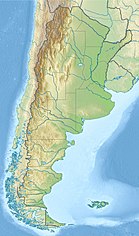Embalse nuclear power plant
| Embalse Nuclear Power Station | |
|---|---|
 |
|
| Official name | Central Nuclear Embalse |
| Country | Argentina |
| Coordinates | 32°13′55″S 64°26′35″W / 32.232°S 64.443°WCoordinates: 32°13′55″S 64°26′35″W / 32.232°S 64.443°W |
| Status | Renovating |
| Construction began | 1974 |
| Commission date | January 20, 1984 |
| Operator(s) | Nucleoeléctrica Argentina Sociedad Anónima |
| Nuclear power station | |
| Reactor type | PHWR |
| Reactor supplier | CANDU |
| Power generation | |
| Units operational | |
| Units under const. | 683 MW |
| Thermal capacity | 2,015 MWt |
| 2009 output | 5,192 GW·h |
|
Website www |
|
The Embalse Nuclear Power Station (Spanish: Central Nuclear Embalse) is one of the three operational nuclear power plants in Argentina. It is located on the southern shore of a reservoir on the Río Tercero, near the city of Embalse, Córdoba, 110 km south-southwest of Córdoba City.
The plant is a CANDU Pressurised Heavy Water Reactor (PHWR). It employs natural uranium (that is, with 0.72% of 235U), and uses heavy water for cooling and neutron moderation. It has a thermal power of 2,109 MWth, and generates 648 MWe of electricity, with a net output of about 600 MWe, supplying nearly 4.5% of the production of the Argentine Interconnection System (2005).
Additionally, Embalse produces the cobalt-60 radioisotope, which is employed in medicine (cancer therapy) and industrial applications. Argentina is one of the largest producers and exporters of this isotope in the world, along with Canada and Russia.
Embalse was started in 1974 and began operation in 1983 (first criticality March 13, 1983, declared commercial Jan 20 1984). It was built by an Italian-Canadian consortium formed by AECL, acting as the "turn-key" supplier of the nuclear portion, and , the "turn-key" supplier of the conventional portion.
...
Wikipedia

